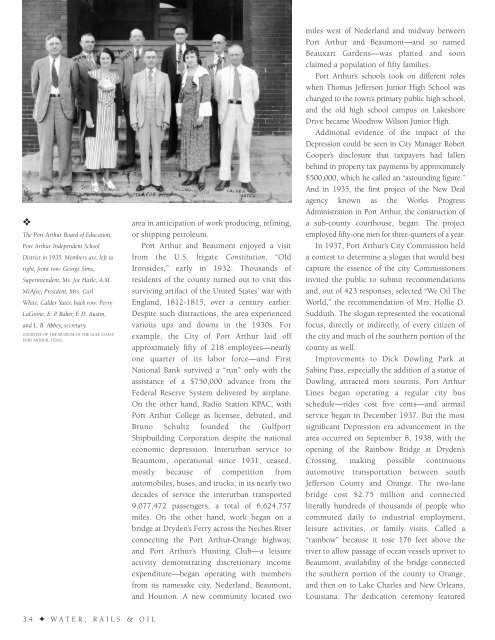Water Rails & Oil - Historic Mid & South Jefferson County
An illustrated history of the Mid and South Jefferson County area, paired with the histories of companies, families and organizations that make the region great.
An illustrated history of the Mid and South Jefferson County area, paired with the histories of companies, families and organizations that make the region great.
Create successful ePaper yourself
Turn your PDF publications into a flip-book with our unique Google optimized e-Paper software.
❖<br />
The Port Arthur Board of Education,<br />
Port Arthur Independent School<br />
District in 1935. Members are, left to<br />
right, front row: George Sims,<br />
Superintendent, Ms. Joe Harle, A.M.<br />
McAfee, President, Mrs. Carl<br />
White, Calder Yates; back row: Perry<br />
LaGrone, E. P. Baker, F. D. Austin,<br />
and L. B. Abbey, secretary.<br />
COURTESY OF THE MUSEUM OF THE GULF COAST,<br />
PORT ARTHUR, TEXAS.<br />
area in anticipation of work producing, refining,<br />
or shipping petroleum.<br />
Port Arthur and Beaumont enjoyed a visit<br />
from the U.S. frigate Constitution, “Old<br />
Ironsides,” early in 1932. Thousands of<br />
residents of the county turned out to visit this<br />
surviving artifact of the United States’ war with<br />
England, 1812-1815, over a century earlier.<br />
Despite such distractions, the area experienced<br />
various ups and downs in the 1930s. For<br />
example, the City of Port Arthur laid off<br />
approximately fifty of 218 employees—nearly<br />
one quarter of its labor force—and First<br />
National Bank survived a “run” only with the<br />
assistance of a $750,000 advance from the<br />
Federal Reserve System delivered by airplane.<br />
On the other hand, Radio Station KPAC, with<br />
Port Arthur College as licensee, debuted, and<br />
Bruno Schultz founded the Gulfport<br />
Shipbuilding Corporation despite the national<br />
economic depression. Interurban service to<br />
Beaumont, operational since 1931, ceased,<br />
mostly because of competition from<br />
automobiles, buses, and trucks; in its nearly two<br />
decades of service the interurban transported<br />
9,077,472 passengers, a total of 6,624,757<br />
miles. On the other hand, work began on a<br />
bridge at Dryden’s Ferry across the Neches River<br />
connecting the Port Arthur-Orange highway,<br />
and Port Arthur’s Hunting Club—a leisure<br />
activity demonstrating discretionary income<br />
expenditure—began operating with members<br />
from its namesake city, Nederland, Beaumont,<br />
and Houston. A new community located two<br />
miles west of Nederland and midway between<br />
Port Arthur and Beaumont—and so named<br />
Beauxart Gardens—was platted and soon<br />
claimed a population of fifty families.<br />
Port Arthur’s schools took on different roles<br />
when Thomas <strong>Jefferson</strong> Junior High School was<br />
changed to the town’s primary public high school,<br />
and the old high school campus on Lakeshore<br />
Drive became Woodrow Wilson Junior High.<br />
Additional evidence of the impact of the<br />
Depression could be seen in City Manager Robert<br />
Cooper’s disclosure that taxpayers had fallen<br />
behind in property tax payments by approximately<br />
$500,000, which he called an “astounding figure.”<br />
And in 1935, the first project of the New Deal<br />
agency known as the Works Progress<br />
Administration in Port Arthur, the construction of<br />
a sub-county courthouse, began. The project<br />
employed fifty-one men for three-quarters of a year.<br />
In 1937, Port Arthur’s City Commission held<br />
a contest to determine a slogan that would best<br />
capture the essence of the city. Commissioners<br />
invited the public to submit recommendations<br />
and, out of 423 responses, selected “We <strong>Oil</strong> The<br />
World,” the recommendation of Mrs. Hollie D.<br />
Sudduth. The slogan represented the vocational<br />
focus, directly or indirectly, of every citizen of<br />
the city and much of the southern portion of the<br />
county as well.<br />
Improvements to Dick Dowling Park at<br />
Sabine Pass, especially the addition of a statue of<br />
Dowling, attracted more tourists, Port Arthur<br />
Lines began operating a regular city bus<br />
schedule—rides cost five cents—and airmail<br />
service began in December 1937. But the most<br />
significant Depression era advancement in the<br />
area occurred on September 8, 1938, with the<br />
opening of the Rainbow Bridge at Dryden’s<br />
Crossing, making possible continuous<br />
automotive transportation between south<br />
<strong>Jefferson</strong> <strong>County</strong> and Orange. The two-lane<br />
bridge cost $2.75 million and connected<br />
literally hundreds of thousands of people who<br />
commuted daily to industrial employment,<br />
leisure activities, or family visits. Called a<br />
“rainbow” because it rose 176 feet above the<br />
river to allow passage of ocean vessels upriver to<br />
Beaumont, availability of the bridge connected<br />
the southern portion of the county to Orange,<br />
and then on to Lake Charles and New Orleans,<br />
Louisiana. The dedication ceremony featured<br />
34 ✦ WATER, RAILS & OIL
















